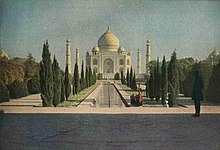Photography in India
Whilst the early history of the photography in the Punjab is shrouded in mystery, the first photographs taken of Sikhs of whom the identity of the lensman is known were snapped by John McCosh, a British military surgeon employed by the East India Company who had been stationed at Firozpur.
[2] In 1848, McCosh snapped a portrait photograph of the then reigning 10-year-old child monarch, Maharaja Duleep Singh of the Sikh Empire, seated on a chair in a profile pose.
[2] One of the earliest photographers of the Golden Temple in Amritsar was a man by the name of Charles Waterloo Hutchinson, he clicked a photo of the site in 1856, around seven years after the fall of the Sikh kingdom.
[2] Some specimens he portrayed in his photographic works include Akali-Nihangs, Sikh soldiers employed in the colonial military (such as in Hodson's Horse), and various views of the Golden Temple shrine and complex of Amritsar.
[2] Prominent photographers and studios who captured Golden Temple and other Sikh sites in the 19th and early 20th centuries with their lens' were Samuel Bourne (1863–65), John Edward Saché (1860s), William Baker (1864–66), James Craddock (1868–70), W. G. Stretton (1870), Baker & Burke (1872), Bourne & Shepherd (1880s–90s), A. Skeen (1900), Hannah P. Adams (1906), Herbert G. Ponting (1906), Underwood & Underwood (1908), Stereo Travel Co. (1908), and H. Templar (1910).
In 2020, Dar Yasin, Mukhtar Khan and Channi Anand became the first Indian photographers to win the Pulitzer Prize for their coverage of the protests in Kashmir.


